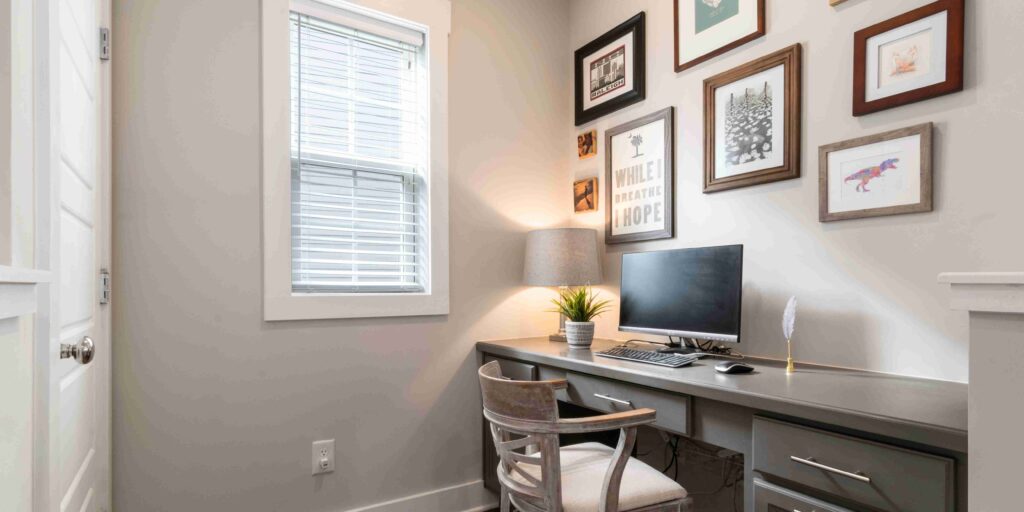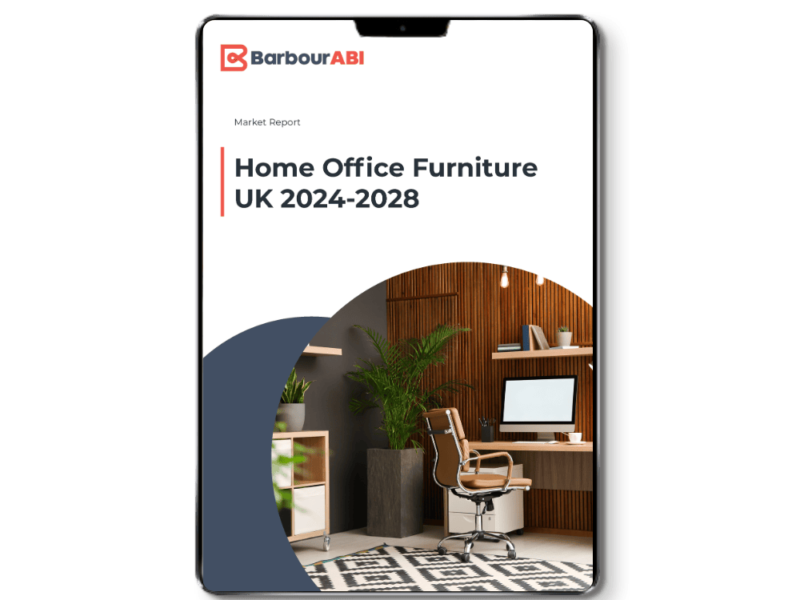The Evolution of Work from Home: An Insight into the UK Home Office Furniture Market

The UK home office furniture market is forecasted to have a marginal increase of +1% in 2028. The 16th edition of the UK home office furniture market report presents our forecast from 2024 to 2028 for the following products:
- Home desking — includes desks, computer tables and integrated tables and storage systems, such as workstations.
- Home office seating — includes executive chairs, adjustable and non-adjustable task seating, secretarial and executive seating, but excludes reception and domestic seating.
- Home office storage — includes filing cabinets, office shelving units, printer stands, bookcases specific to home offices.
Overview of the Home Office Furniture Market
The UK home office furniture market was impacted by recent economic shocks and current uncertainties.
However, increasing popularity for flexible and remote working settings offer opportunities for the market. We find strong price competition in the supply market, particularly with the popularity of flat pack products, despite design remaining a major decision factor for consumers.
Further, internet shopping is a strong determinant of distribution channels’ competitiveness. After a period of instability starting in 2020, we expect the market to stabilise itself in the next five years, and innovations to revolve around ergonomic and space efficient designs.
Economic Impact
Since 2019, the UK home office furniture market has been receptive to economic shocks, thus impacting its stability with lows — -8% marginal growth in 2020 —, and highs, — +12% marginal growth in 2021.
Nonetheless, despite current economic uncertainties following geopolitical instability, the market is expected to stabilise itself with a marginal growth of +1% in 2028 reaching £195m at Manufacturer Selling Price (MSP). Current economic uncertainties impacted consumers expenditures, who now favour budget home office furniture, with a majority coming from flat pack imports from low-cost producers.
Furthermore, consumer characteristics are shifting towards smaller houses and multi-generational housing, lowering the capacity for home office building and improvements.
Single occupancy households simultaneously increased, though more slowly than multigenerational households. Therefore, increase in homeworking and single occupancy may work as a counter-effect to multi-generational households and smaller space in the long-term.
New market opportunities will arise from trade agreements with non-EU countries in the medium to long term, such as with the Comprehensive and Progressive Agreement for Trans-Pacific Partnerships (CPTPP).
Additionally, interest rates are predicted to decrease in the next two years. Design and quality remain a major consumption driver, although the growing presence of internet shopping intensifies price competition.
Finally, greater ESG practices and internal commitments to net wero are also boosting business performances, leading to the use of more sustainable raw materials for instance.
Market Segmentation
The largest market sectors in the UK home office furniture products are desk, tables, and seating products, constituting 85% of the market.
Despite the UK’s current economic situation impacting new housing construction output, the niche market for executive houses remains a sector of opportunities for this market. With products popularity determined by availability and cost/price competitiveness, most home office furniture products in the UK are flat pack furniture.
Competition is also driven by technological development, space efficiency, and ergonomic and comfortable designs; with wood finishes being highly popular due to a growing desire to match other home furniture.
Major suppliers include Dams Furniture, Nautilus Designs, Alphason Designs, Tvilum — supplying flat pack furniture to UK customers such as John Lewis—, Boss Design — operating in the higher end of the market. Some companies specialise in wholesale and import of home office furniture (Teknik Office, Julian Bowen). Other companies specialise in the supply of home office furniture only (Hody, Ebonium), and others offer an installation service (Sharps Bedrooms, Hammonds Furniture, Neville Johnson).
Home Office Furniture Distribution
The distribution of home office furniture products in the UK is composed of four channels — online and mail order, retail outlets, dealers, and direct from manufacturers.
Internet shopping has become increasingly popular, leading online and mail order to become the main distributor channel for home office furniture. Under intense price competition, we count Argos, Viking, Staples, Lyreco, and Office Depot as important distributors for the online and mail order channel. Due to its popularity, new online-only distributors intensified competition by entering this distribution channel (e.g. National Office Furniture Supplies, Office Furniture Online). Under the retail outlets channel, we find Ikea and John Lewis as major supplier of home office furniture, a few other distributors offer a smaller range of products (e.g. Furniture Village, Ryman), and some are fitted furniture specialist offering home office furniture among other products (e.g. Sharps Bedrooms, Neville Johnson).
Office furniture dealers principally supply companies; therefore, companies use them to provide furniture pack for home use. Home office furniture is more rarely distributed directly by manufacturers.
Demand for Home Office Furniture
A downward trend in demand for offices since 2017 underlines opportunities for more home working in the future.
Technological development enhanced the use of wireless technologies, with online collaboration tools embedded in one device which eases transitions to home working. Nonetheless, such improvements impact the home office storage sector with the spread of cloud-based storage limiting the need for storage products.
If remote working continues to grow in the future, companies will encounter greater regional market opportunities outside city hubs. Nonetheless, lack of space in the average UK household remains a potential barrier to growth.
To counter the lack of space, the decrease of new private house construction, and tackle opportunities within younger age groups (students) and gaming units, manufacturers aim to offer more ergonomic designs incorporating desks, seating, and storage with other home furniture units such as bed frames.
Consequently, the UK home office furniture market is likely to become even more dependent on design efficiency in the short term.
Recent Posts
- Key Trends and Market Dynamics in the UK Bricks, Blocks & Precast Concrete Sector
- Navigating Market Volatility: The Future of the UK Kitchen and Bathroom Distributors
- UK Kitchen and Bathroom Distribution: Growth, Challenges, and Opportunities
- Diesel Dominance and the Rise of Green Alternatives in the UK Generator Market
- From Diesel to Hybrid: Barbour ABI Maps UK Generator Hire Market Evolution
Categories
Archives
Share
Featured Report
-

Home Office Furniture Market Report UK 2024-2028
£1,499.00 Exc. VAT Add to BasketThe 16th edition of the Home Office Market Report – UK 2024-2028 features an insightful view on the implications for suppliers and product manufacturers of the changes in the industry. This new report will incorporate industr...


